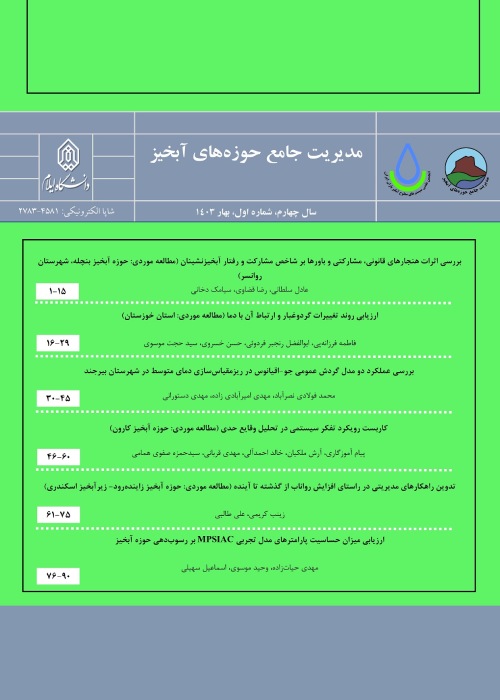Determining the Potential of Nature Tourism Using System Analysis Method in Kojour Nowshahr Summer Pastures
Nature tourism includes all forms and types of tourism, but the factors used to classify the different forms of tourism are not the same. In the ecological model of tourism, recreation is divided into two types: centralized and extensive. Centralized recreation includes those recreations that need to be developed, such as swimming, skiing, camping, etc. Extensive recreation includes activities that do not require development, such as mountaineering and hunting, or require little development, such as fishing, hiking, horseback riding, and wildlife watching, each of which is grouped into the first and the second class and unsuitable for recreation (Makhdom, 2010). Abbasi et al. (2022) in a study with the aim of designing a rural ecotourism entrepreneurship development model in Dezful city used a qualitative type in terms of implementation method, a mixture of qualitative content analysis and Delphi technique, and showed that the combination of social responsibility, biological responsibility, growth and development through ecotourism, ecotourism innovations, and creativity leads to the development of rural entrepreneurship.
In order to determine the natural tourism potential of Kojour summer rangelands, the system analysis method, which is the most common method of identifying, evaluating and planning land productivity in Iran, was used. In the first stage, ecological resources were identified. Ecological resources including physical resources (slope, direction, altitude and soil), etc. were prepared from a 1:25000 digital topographic map. By superimposing these three maps, a single map of the earth's shape was obtained. The next step involved analyzing and summarizing the resources, which in this step was prepared by combining and superimposing the earth shape map and other maps.
The initial recreation map was prepared in three floors. According to the initial recreational map, 0.61% of the study area has a wide recreational capacity of the first floor, 65.22% of the area has a wide recreational capacity of the second floor and 34.17 % of the area is unsuitable for recreation. According to these results, most of the area has a wide recreational capacity of the second floor with an area of 14486.95 ha. According to the final recreation plan and table 3, Chenarbon rangeland with an area of 1514.29 ha has a wide recreational capacity of the second floor, Dasht Lashak rangeland with an area of 79.74 ha, of which 46.51% has a wide recreational capacity of the second floor and 53.49% is unsuitable for recreation, also Islamabad rangeland with an area of 28.87 ha, of which 75.2% has a wide recreation capacity of the second floor and 24.98% is unsuitable for recreation, and the Kohneh Lashak rangeland with an area of 128.56 ha, of which 96.19 % has a wide recreational capacity of the second floor and 3.81% is unsuitable for recreation. In addition, Kojour rangeland has an area of 652.74 ha, of which 87.24% has a wide recreational capacity of the second floor and 12.76% is unsuitable for recreation, Lorgan rangeland has an area of 51.80 ha, of which 12.54% has a wide recreational capacity of the second floor and 87.46% is unsuitable for recreation, and Pideh rangeland has an area of 31.9168 ha of which 57.31% has a wide second-class recreation capacity and 42.69% has unsuitable recreation. Kojour summer area is in good condition in terms of slope factor for recreational planning, especially extensive recreation. In the studies of Kumari et al. (2010) slope layer has also been used as an important factor in evaluating recreational power. The north and east directions are usually suitable for summer recreation and the south and west directions are suitable for winter recreation (Makhdom, 2010). The results of the vegetation map showed that most of the area (31.43%) includes agricultural lands and gardens, which makes the area unsuitable for recreation, and the rest of the area with forest and pasture cover with canopy density between 5 and 50 percent is suitable for extensive recreation of first and second class, which is consistent with the results of Parham et al. (2011). Loamy soils are very suitable soils for recreation (Mahmoudi, 2006; 2007; Takihkhah, 2008). In general, there is no restriction in soil texture for ecotourism use in the study area, in Farajzadeh & Karimpanah. (2008), distance from water resources was used as an important factor in assessing the recreational potential of the region. Results of studies (Mahmoudi, 2006; 2007; Takihkhah, 2008; Ahmadsani et al., 2008) also showed that distance from water resources is one of the key factors in evaluating recreational power. Access routes can increase the amount of recreation, and in principle recreational planning for areas with recreational potential is consistent with studies (Mahmodi, 2006; Takihkhah, 2008). High-pressure faults and power towers are among the limiting factors in the region that lead to reduced recreation.
The results of determining the potential of the region showed that this region has a wide recreational capacity of the first and second floors. The results showed that 65.83% of the region has recreational potential and 34.17% of the region is unsuitable for recreation due to the high slope, high altitude and the presence of agricultural lands and gardens in the area. Also, among the seven rangelands studied, Chenarbon rangeland has the best resort conditions due to having all the recreational conditions. Therefore, it is possible to suggest the rangelands of the region, with the exception of high-altitude and sloping rangelands, especially Chenarbon rangelands, for tourism, and to teach its users the necessary practical and managerial measures for this purpose.
- حق عضویت دریافتی صرف حمایت از نشریات عضو و نگهداری، تکمیل و توسعه مگیران میشود.
- پرداخت حق اشتراک و دانلود مقالات اجازه بازنشر آن در سایر رسانههای چاپی و دیجیتال را به کاربر نمیدهد.


